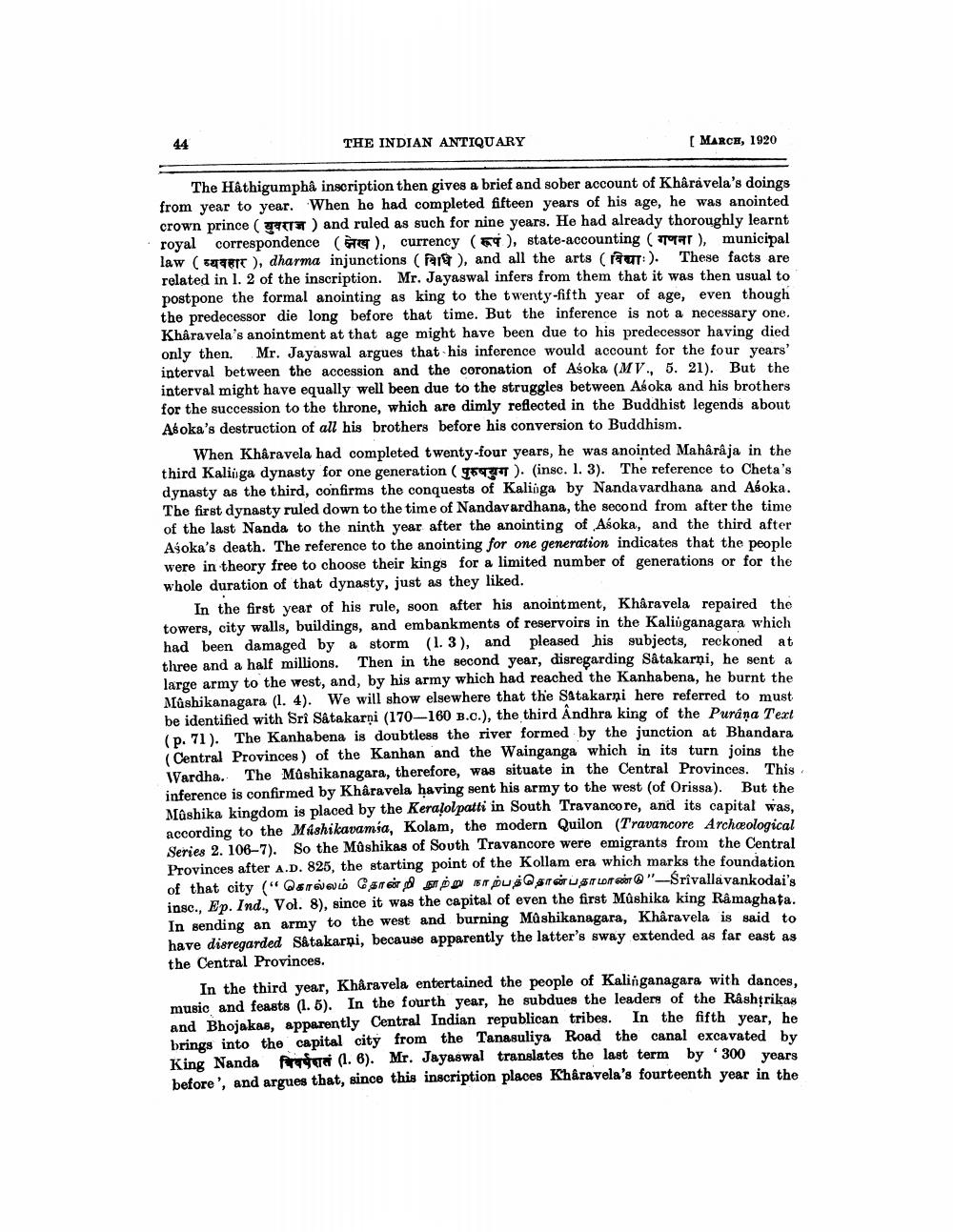________________
44
THE INDIAN ANTIQUARY
[ MARCH, 1920
The Hâthigumphâ inscription then gives a brief and sober account of Khâravela's doings from year to year. When he had completed fifteen years of his age, he was anointed crown prince () and ruled as such for nine years. He had already thoroughly learnt royal correspondence (), currency (), state-accounting (TTT), municipal These facts are law (set), dharma injunctions (Fr), and all the arts (fr:). related in 1. 2 of the inscription. Mr. Jayaswal infers from them that it was then usual to postpone the formal anointing as king to the twenty-fifth year of age, even though the predecessor die long before that time. But the inference is not a necessary one. Khâravela's anointment at that age might have been due to his predecessor having died only then. Mr. Jayaswal argues that his inference would account for the four years' interval between the accession and the coronation of Asoka (MV., 5. 21). But the interval might have equally well been due to the struggles between Aśoka and his brothers for the succession to the throne, which are dimly reflected in the Buddhist legends about Asoka's destruction of all his brothers before his conversion to Buddhism.
When Khâravela had completed twenty-four years, he was anointed Mahârâja in the third Kalinga dynasty for one generation (q). (insc. 1. 3). The reference to Cheta's dynasty as the third, confirms the conquests of Kalinga by Nandavardhana and Aśoka. The first dynasty ruled down to the time of Nandavardhana, the second from after the time of the last Nanda to the ninth year after the anointing of Aśoka, and the third after Aśoka's death. The reference to the anointing for one generation indicates that the people were in theory free to choose their kings for a limited number of generations or for the whole duration of that dynasty, just as they liked.
In the first year of his rule, soon after his anointment, Khâravela repaired the towers, city walls, buildings, and embankments of reservoirs in the Kalinganagara which had been damaged by a storm (1.3), and pleased his subjects, reckoned at three and a half millions. Then in the second year, disregarding Satakarni, he sent a large army to the west, and, by his army which had reached the Kanhabena, he burnt the Mûshikanagara (1. 4). We will show elsewhere that the Satakarni here referred to must be identified with Sri Satakarni (170-160 B.C.), the third Andhra king of the Purana Text (p. 71). The Kanhabena is doubtless the river formed by the junction at Bhandara (Central Provinces) of the Kanhan and the Wainganga which in its turn joins the Wardha. The Mûshikanagara, therefore, was situate in the Central Provinces. This inference is confirmed by Khâravela having sent his army to the west (of Orissa). But the Mûshika kingdom is placed by the Keralolpatti in South Travancore, and its capital was, according to the Mishikavamia, Kolam, the modern Quilon (Travancore Archæological Series 2. 106-7). So the Mûshikas of South Travancore were emigrants from the Central Provinces after A.D. 825, the starting point of the Kollam era which marks the foundation of that city "கொல்லம் தோன்றி நூற்று நாற்பத்தொன்பதாமாண்டு "-Srivallavankodai's insc., Ep. Ind., Vol. 8), since it was the capital of even the first Mûshika king Râmaghata. In sending an army to the west and burning Mûshikanagara, Khâravela is said to have disregarded Satakarni, because apparently the latter's sway extended as far east as the Central Provinces.
In the third year, Khâravela entertained the people of Kalinganagara with dances, music and feasts (1. 5). In the fourth year, he subdues the leaders of the Râshtrikas and Bhojakas, apparently Central Indian republican tribes. In the fifth year, he brings into the capital city from the Tanasuliya Road the canal excavated by King Nanda sud (1.6). Mr. Jayaswal translates the last term by 300 years before', and argues that, since this inscription places Khâravela's fourteenth year in the




